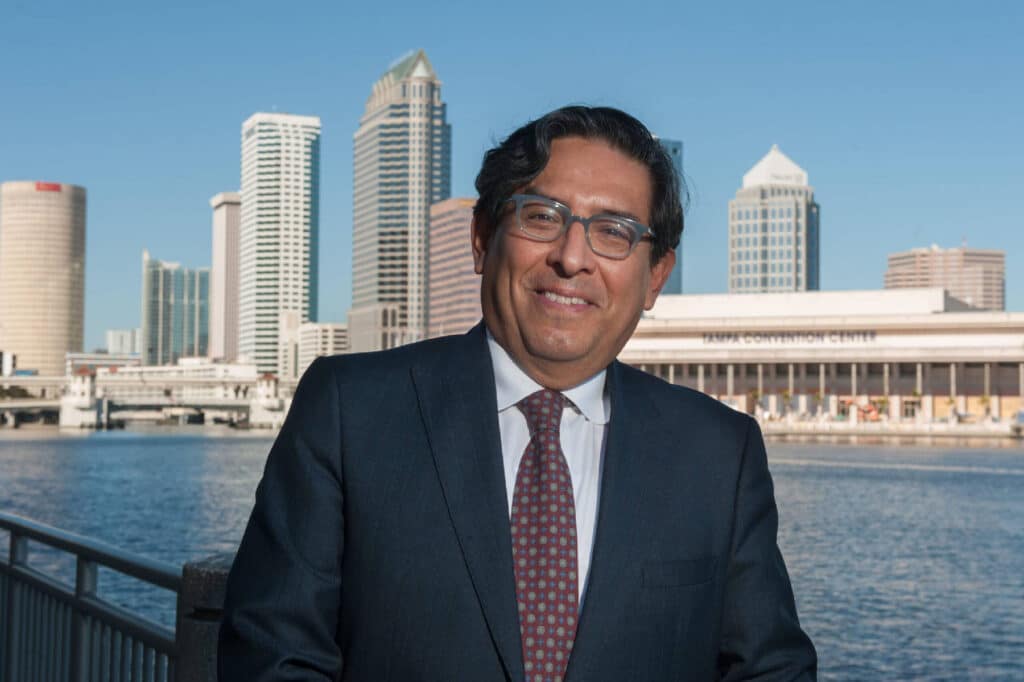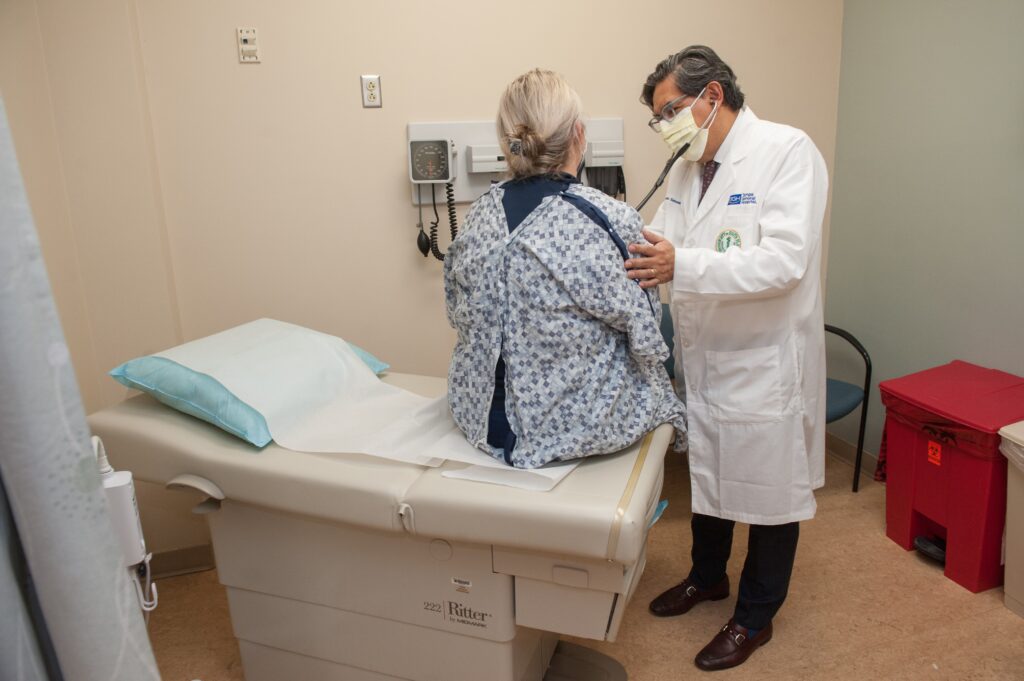
News
A Pioneering Spirit

Lymphoma Research Foundation (LRF) grantee and Scientific Advisory Board (SAB) member Eduardo M. Sotomayor, MD was recently named director of Tampa General Hospital’s newly established Cancer Institute. This appointment marks a new and exciting challenge for the world-renowned lymphoma expert—combining his pioneering work in cancer immunology and immunotherapy with his dedication to providing quality cancer care for all patients—in hopes of finding cures for lymphoma.
RIDING THE WAVES TO HIS PASSION
Dr. Sotomayor lives and works in Tampa, Fla., on the shores of the Gulf of Mexico. The Gulf’s steady waves are very familiar and remind him of his childhood swimming the Pacific Ocean in his hometown of Puerto San Juan de Marcona, Peru. “My life has always been associated with the ocean and the coast, and it has defined my easygoing personality,” says Dr. Sotomayor. “There is something about living by the sea that makes you enjoy life and have fewer worries.”
But life, like water, does not always flow smoothly. While playing in his parents’ kitchen when he was 5 years old, boiling water spilled on his face, arm, and leg and left him badly burned. However, life sometimes reveals opportunity in misfortune.
“I spent three months in the hospital, and at that age, the doctors and nurses talk to you, and they make you laugh,” he recalls. “I thought, ‘This is very interesting. I like these guys.’ Pediatricians are a special group of people and play an important role in a child’s healing. I’ll always remember how they helped and inspired me.”
Later, an uncle studying medicine in Lima, Peru, visited his family and enthralled him with his stories about becoming a doctor. Those experiences helped Dr. Sotomayor find his calling: becoming a doctor. He attended medical school at Federico Villarreal National University School of Medicine in Lima, performed his residency at Jackson Memorial Medical Center with the University of Miami School of Medicine in Florida, and completed his fellowship in hematology/oncology at Johns Hopkins University School of Medicine in Baltimore, Md.
During his time at Federico Villarreal National University, Dr. Sotomayor’s interest in the immune system was piqued by a former student, Francisco La Rosa, who migrated to the United States to perform immunology research and often returned to Federico Villarreal to teach medical students. The burgeoning field of tumor immunology grabbed his attention.
We were considered dreamers in the field. But today, tumor immunology has proven successful, and there are effective immunotherapies to treat various cancers.
“He talked about the immune system and how it needs to be tightly controlled,” Dr. Sotomayor recalls. “He said one of the functions of the immune system is to fight infection, and there was emerging evidence that the immune system could one day fight cancer. Very few researchers were focusing on tumor immunology—it was a new frontier.”
From there, Dr. Sotomayor embarked on a journey to confront challenges few have explored and sought to answer the most challenging questions in medical science.
INVESTIGATIONS ON THE BATTLEFIELD
In 1988, Dr. Sotomayor began working in tumor immunology with Dr. Diana Lopez at the University of Miami Miller School of Medicine. At that time, he recalls tumor immunology was not an established study or common area of research focus.
“We were considered dreamers but without a future in oncology, because of the prevalent skepticism at that time towards the emerging field of tumor immunology. But today, tumor immunology has proven successful, and there are effective immunotherapies to treat almost every type of cancer,” he says. “Having committed my life to research and understanding this new treatment modality, I can tell you that we are just seeing the tip of the iceberg.”
From Miami, Dr. Sotomayor headed north to Baltimore to become an oncology fellow at Johns Hopkins and further pursue tumor immunology. In his first year, he learned to treat cancer patients, cultivating a sense of compassion. In his second and third years, he conducted research and was assigned to study lymphoma and its interaction with the immune system. There, his passion for both researching cures and treating lymphoma began.
“I’ve found that to be an efficient clinical investigator or physician-scientist, you should continue to treat patients,” says Dr. Sotomayor. “As a clinician, you can recognize early if treatment is or isn’t working or if there are side effects. You can take these observations and apply them to your lab to further investigate.
Dr. Sotomayor’s research involves investigating what he calls a battlefield. He describes the T-cells of the immune system and tumor (cancer) cells as two armies fighting a war within the lymph nodes. While studying this internal fight, he and his team were among the first researchers to show in an experimental model of lymphoma that the tumor cells can control the T-cells and order them not to attack.
“They reach a peace agreement, so the tumor cells say, ‘Do not attack me,’ and the T-cell will say, ‘Let’s live together.’ But they are going to try to cheat each other,” he says. “It’s a constant dynamic, and at some point, one is going to win.”
His research delves deeply into understanding this interaction on a cellular and molecular level, the role the lymphoma microenvironment plays in this interaction, and what strategies each opponent uses on the battlefield. Through this hyperfocused research, Dr. Sotomayor has made great strides and contributions regarding how molecular mechanisms, signaling pathways, epigenetics, and the lymphoma microenvironment influence immune responses against lymphomas.
A FOCUS ON RARE LYMPHOMA
Just like he was drawn to the challenge of the emerging field of tumor immunology, Dr. Sotomayor has focused much of his research on mantle cell lymphoma (MCL), an aggressive and rare form of non-Hodgkin lymphoma. Patients with MCL are typically diagnosed at a later stage of the disease and represent only six percent of all non-Hodgkin lymphomas, making them a historically understudied and underserved population.
“We now have several novel targeted therapies for MCL, including chimeric antigen receptor therapy, also known as CAR T cell therapy,” he says. “Significant advances have been made studying mantle cell lymphoma, and it is a great focus of mine.”
Outside of the National Cancer Institute (NCI), most of the advances in mantle cell lymphoma are made by researchers funded by LRF…and I would say a significant portion of the advances in lymphoma are because of LRF, period.
Dr. Sotomayor believes that LRF has profoundly impacted his research and researchers’ overall understanding of MCL. In 2004, he received a Mantle Cell Lymphoma grant through LRF’s Mantle Cell Lymphoma Initiative— a research endeavor focusing on funding MCL research and accelerating developments in the understanding and treatment of MCL—to conduct the first vaccine trial for the disease.
“Outside of the National Cancer Institute (NCI), most of the advances in mantle cell lymphoma are made by researchers funded by LRF,” says Dr. Sotomayor. “I think it is fair to say they have changed the history of new formulation and treatment, and I would say a significant portion of the advances in lymphoma are because of LRF, period.”
Furthering his impact on MCL research and patient care, Dr. Sotomayor became a member of LRF’s Mantle Cell Lymphoma Consortium (MCLC) in 2005, joined the Executive Committee in 2015, and was elected Chair in 2021. The MCLC is comprised of 37 international laboratory and clinical scientists whose research is focused on MCL. Members of the MCLC convene biennially for a global scientific workshop to discuss the latest research findings, foster collaboration within the MCL research community and create new directions for research, all to improve the diagnosis and treatment for this disease. As Chair of the MCLC, Dr. Sotomayor hopes to bring together the brightest minds from all different areas of study to provide fresh perspectives to the study of MCL and advance LRFs MCL Initiative.
“There are brilliant scientists within the consortium who are all dedicated and have the potential to make a great impact,” says Dr. Sotomayor. “I am looking forward to working with them over the next two years to help move the research needle forward and advance our understanding of this disease.”
AN EVER-GROWING RELATIONSHIP WITH LRF
In addition to the MCL grant, Dr. Sotomayor received two other LRF research grants, including a Postdoctoral Fellowship and a Junior Faculty Award. He feels LRF’s impact on research and advancing cures cannot be understated, and the Foundation is one of the leading funders of lymphoma research. With a more significant investment in research, Dr. Sotomayor believes there are significant opportunities to find cures.
“There are talented scientists all over the world, but they need support,” says Dr. Sotomayor. “The first grant I received from LRF kick-started my career and allowed me to put in long hours to develop and establish my place as a researcher and successfully compete for federal NIH/NCI grants.”
Dr. Sotomayor sees the impact of LRF’s grant program beyond funding research. “It’s the message it sends—the Foundation believes in you, even if you think you have the craziest idea,” he says. “LRF’s incredible Scientific Advisory Board views that crazy idea as a potential breakthrough or discovery. It motivates and excites researchers and keeps them in the field. The more LRF can fund, the more we can advance.”

A NEW FRONTIER
In his new role as director of Tampa General Hospital’s Cancer Institute, Dr. Sotomayor aims to bring in new voices, recruit the best and brightest scientists, including those beyond the oncology field (i.e., engineers, physicists, and chemists, among others) to conduct advanced research, and provide the next breakthroughs in cancer care leading to the best care of cancer patients.
“I will define Tampa General Hospital’s Cancer Institute as innovative, compassionate, and collaborative—we care, and we want to have an impact in our community,” he says. “Our priority is to use the latest research and therapies to provide the best care to patients in Florida and beyond, with special emphasis in breaking the barriers to access to cancer care.”
One of his priorities will be advancing the understanding of the biology of hematologic malignancies through new diagnostic tools like biomarker testing. Next-generation sequencing is helping scientists and clinicians to identify mutations (abnormalities) in tumor cells. Next-generation sequencing can also help identify these mutations in people with diseases other than cancer, like heart disease —an emerging field of study called clonal hematopoiesis of indeterminate prognosis (CHIP). Sotomayor hopes to further understand the connection between these diseases and cancer. He is developing a partnership with cardiologists at the USF Health Morsani College of Medicine to bring together oncologists and cardiologists to research these abnormalities.
“This will help identify the next big question in cancer and how disciplines beyond oncology working side by side with us would provide answers to that question,” he says. At the forefront of Dr. Sotomayor’s work will always be his MCL research and his drive to ensure Tampa General Hospital continues to care for its diverse community on the Gulf, where the water reminds him of the birthplace of his pioneering spirit—home.
Read More Articles from Pulse
Pulse is a publication of the Lymphoma Research Foundation, providing the latest updates on the Foundation and its focus on lymphoma and chronic lymphocytic leukemia (CLL) research, awareness, and education